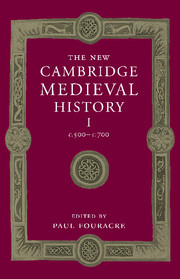Book contents
- Frontmatter
- Introduction: the history of Europe 500–700
- 1 The later Roman Empire
- 2 The Barbarian invasions
- 3 The sources and their interpretation
- PART I THE SIXTH CENTURY
- PART II THE SEVENTH CENTURY
- PART III THEMES AND PROBLEMS
- 20 The Jews in Europe 500–1050
- 21 Kings and kingship
- 22 The Mediterranean economy
- 23 The Northern Seas (fifth to eighth centuries)
- 24 Money and coinage
- 25 Church structure and organisation
- 26 Christianisation and the dissemination of Christian teaching
- 27 Education and learning
- 28A Art and architecture of western Europe
- 28B Art and architecture: the East
- List of Primary sources
- Bibliography of secondary works arranged by chapter
- Index
- Frontispiece"
- Plate section"
- Map 3 Gaul/Francia in the sixth and seventh centuries"
- References
25 - Church structure and organisation
from PART III - THEMES AND PROBLEMS
Published online by Cambridge University Press: 28 March 2008
- Frontmatter
- Introduction: the history of Europe 500–700
- 1 The later Roman Empire
- 2 The Barbarian invasions
- 3 The sources and their interpretation
- PART I THE SIXTH CENTURY
- PART II THE SEVENTH CENTURY
- PART III THEMES AND PROBLEMS
- 20 The Jews in Europe 500–1050
- 21 Kings and kingship
- 22 The Mediterranean economy
- 23 The Northern Seas (fifth to eighth centuries)
- 24 Money and coinage
- 25 Church structure and organisation
- 26 Christianisation and the dissemination of Christian teaching
- 27 Education and learning
- 28A Art and architecture of western Europe
- 28B Art and architecture: the East
- List of Primary sources
- Bibliography of secondary works arranged by chapter
- Index
- Frontispiece"
- Plate section"
- Map 3 Gaul/Francia in the sixth and seventh centuries"
- References
Summary
introduction
By the later third century, when it began to be widely persecuted, the Christian community of believers had already created within the Roman Empire the basic forms of church organisation. In the first decade of the third century we see in the work of Tertullian the first signs of a link between Christianity and the Roman legal system, along with an attempt at co-ordination between Christian belief and contemporary philosophy in the writings of Clemens of Alexandria and Origen. But serious disputes with the state over both the separation and the self-government of the church took place during the Constantinian period. At this time the structure of the newly liberated church was clearly in place but the lead that the church in the Eastern Roman Empire had acquired, could not be ignored. There, Christianity could be constructed using the economic and administrative prerequisites of older cultures and therefore it soon reached a high level of organisation. In the West conditions were less favourable. Civilisation was not so far advanced and was at first partly threatened by paganism and barbarianism, which it overcame only slowly. Mediterranean urban culture was not as strong in the West and because of this the church lacked a basis on which to form a full infrastructure. Until the sixth century the church in the West was occupied with solving elementary problems. This task was hindered by the collapse of the unified Western Empire into separate barbarian regimes whose leaders initially had to be converted to Catholicism. This lengthened the transitional phase of the church’s development from an only partly effective, troubled religious sect into an institution with many branches.
- Type
- Chapter
- Information
- The New Cambridge Medieval History , pp. 675 - 709Publisher: Cambridge University PressPrint publication year: 2005
References
- 2
- Cited by



